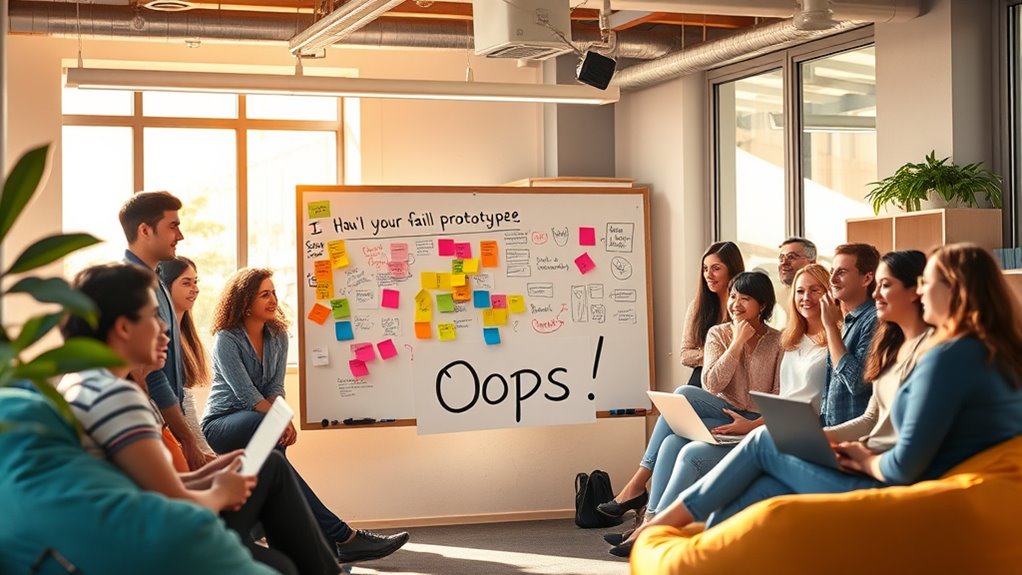A fail-friendly culture encourages you to see mistakes and setbacks as opportunities for learning and growth. By normalizing experimentation, you create an environment where innovation can thrive without fear of failure. This mindset helps your team develop resilience, promote curiosity, and adapt quickly to change. When failure is viewed as a valuable lesson, you build trust and confidence in trying new ideas. Keep exploring to discover how to cultivate this empowering approach in your organization.
Key Takeaways
- A fail-friendly culture encourages experimentation by viewing mistakes as valuable learning opportunities rather than failures.
- Normalizing errors fosters psychological safety, motivating teams to innovate without fear of harsh judgment.
- Emphasizing lessons from setbacks helps organizations adapt quickly and improve processes continuously.
- Establishing safety nets and boundaries allows risk-taking while protecting organizational stability.
- Cultivating a mindset shift promotes resilience, creativity, and long-term growth through strategic failure acceptance.

Have you ever wondered why some organizations thrive despite setbacks? The answer often lies in their ability to foster a fail-friendly culture—an environment where experimentation is encouraged, and mistakes are viewed as valuable learning opportunities. Central to this mindset is cultivating an innovative mindset, which pushes teams to explore new ideas without the fear of failure holding them back. When you embrace a fail-friendly culture, you shift the focus from avoiding errors at all costs to managing risks intelligently. This isn’t about reckless experimentation; it’s about strategic risk management that allows you to test new concepts, learn quickly, and adapt accordingly.
Fostering a fail-friendly culture empowers teams to innovate, learn from mistakes, and adapt strategically for long-term success.
In organizations with a fail-friendly approach, failure isn’t seen as the end of the road but as a stepping stone towards improvement. When you normalize mistakes, you empower your team to take calculated risks that could lead to breakthrough innovations. Instead of punishing failure, leaders celebrate the lessons learned and the insights gained. This approach creates a safe space where creativity flourishes and curiosity is encouraged. As a result, your team becomes more willing to experiment, knowing that setbacks are simply part of the process rather than reasons for reproach. Additionally, fostering a high-innovation environment helps in nurturing this mindset further.
An innovative mindset is essential here because it shifts how you and your team respond to challenges. You learn to see setbacks not as failures but as opportunities for growth. When you view mistakes through this lens, you’re more likely to analyze what went wrong, adjust your strategies, and try again. Over time, this approach builds resilience and agility within your organization. It also promotes continuous improvement, as every misstep becomes a chance to refine your methods and develop better solutions.
Risk management plays a pivotal role in maintaining a fail-friendly culture. Instead of reckless risk-taking, it involves thoughtfully assessing potential pitfalls and setting boundaries that prevent catastrophic failures. When you implement effective risk management practices, you create a safety net that encourages experimentation while protecting the organization from severe setbacks. This balance allows your team to push boundaries and explore innovative ideas confidently, knowing that there are safeguards in place to handle potential failures gracefully.
Ultimately, cultivating a fail-friendly culture requires intentional effort and a shift in mindset. By normalizing mistakes, emphasizing strategic risk management, and fostering an innovative mindset, you create an environment where continuous learning and growth become part of your organization’s DNA. This cultural shift not only increases your chances of success but also keeps your team motivated, engaged, and resilient in the face of inevitable setbacks. When failure is viewed as a natural step in the journey, your organization becomes more adaptable, creative, and prepared to thrive in a constantly changing world.
Frequently Asked Questions
How Can Leadership Effectively Promote a Fail-Friendly Environment?
You can promote a fail-friendly environment by openly communicating the value of risk-taking and learning from mistakes. As a leader, encourage your team to experiment without fear of blame, emphasizing that failure is part of growth. Use transparent leadership communication to share lessons learned from setbacks and support risk management strategies that mitigate negative impacts. This approach fosters trust, innovation, and resilience within your team.
What Are Common Challenges in Shifting to a Fail-Friendly Culture?
You might find it ironic that embracing failure feels riskier than avoiding it. Common challenges include overcoming risk aversion and cultural resistance, which make teams hesitant to experiment. People fear mistakes will tarnish their reputation or threaten job security. To shift mindsets, you need patience, clear communication, and consistent support. Address these barriers head-on, and you’ll foster a truly fail-friendly environment that encourages innovation and learning from setbacks.
How Do Companies Measure Success in a Fail-Friendly Environment?
You measure success in a fail-friendly environment through innovative metrics that focus on learning and growth rather than just outcomes. Failure benchmarks help you track how often and how well you experiment, encouraging continuous improvement. By analyzing these metrics, you can see if your team is embracing risk, adapting quickly, and gaining valuable insights. Success isn’t just about results; it’s about the progress made through smart failures and experimentation.
What Role Does Employee Training Play in Embracing Mistakes?
You play a vital role in fostering a fail-friendly culture through employee training that emphasizes psychological safety and continuous learning. By encouraging open dialogue and normalizing mistakes as learning opportunities, you help employees feel safe to take risks. This training builds confidence, reduces fear of failure, and promotes a mindset where experimentation thrives, ultimately turning mistakes into powerful tools for growth and innovation within your organization.
How Can Organizations Recover From Repeated Failures?
You can recover from repeated failures by fostering an innovation mindset and ensuring psychological safety. Encourage open communication where team members feel safe to share lessons learned without fear of blame. Analyze what went wrong, adapt strategies, and celebrate improvements. By maintaining a growth-oriented environment, you empower your team to view failures as opportunities for learning, ultimately strengthening resilience and driving continuous innovation.
Conclusion
Embracing a fail-friendly culture might sound risky, but it actually fosters growth and innovation. When you see mistakes as learning opportunities rather than setbacks, you create an environment where creativity flourishes. Some might worry about losing control or facing repeated failures, but with the right mindset, you can guide experimentation productively. Remember, every successful idea often starts with a few failures—so don’t fear mistakes; see them as stepping stones to success.









